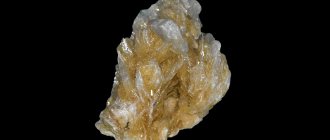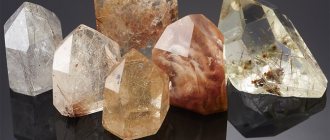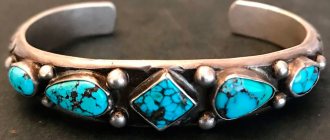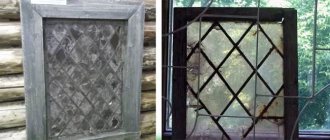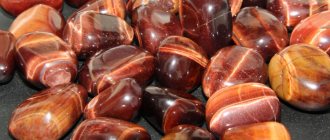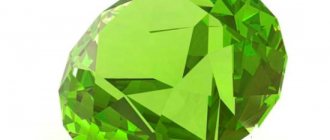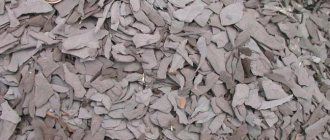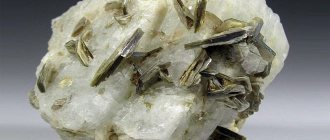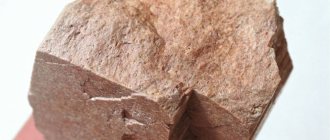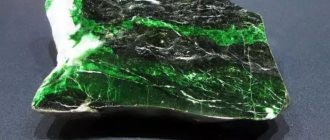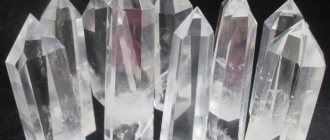If you like minerals that have a green, grassy hue, and are also inexpensive, then epidote stone is ideal.
Sometimes it can be confused with jasper, as there are inclusions of a red tint. But unlike the latter, epidote is a silicate of aluminum, iron and calcium.
In past centuries, epidote has had quite a lot of names. Nowadays, some of the varieties are successfully used in jewelry.
Epidote is little known to a wide range of mineral lovers, but true connoisseurs willingly purchase an unusual stone for their collection.
Today we will study the epidote in as much detail as possible.
Origin story: what kind of stone is this?
For some time, epidote was considered to be a variety of tourmaline. The stone has had dozens of names throughout its history, and its structure has been studied by many luminaries of mineralogy.
Only in 1801, a physicist from France, Hauis, isolated epidote as a separate mineral, which has varieties. You can read about this in the works of the scientist.
Currently, the mineral has been well studied: 300 years after its first discovery, it has fully confirmed characteristics by experts.
This is a complex silicate, which invariably contains a high level of calcium and an alternating content of iron and aluminum impurities.
It has hardness and a characteristic luster in nature and cut, which attracts mineral connoisseurs.
Under different lighting conditions, epidote can change color. And being under the sun's rays it becomes dark, accumulating light in the crystals.
The mineral is formed as a result of changes in rocks during contact metamorphism and in large veins of the Alps.
Untreated crystals are formed correctly, and if they do not have additional impurities, they are characterized by asymmetrical faces.
Epidote is often confused with Vesuvian due to its external similarity and due to its similar color palette.
Caring for products containing epidote
This practical and hard mineral is not prone to cracks, easily coexists with other stones, is not afraid of mechanical damage and easily tolerates household chemicals. But if it falls, it may split. To preserve its original appearance, wash it with a soft cloth, warm soapy water, rinse with running water and dry well.
The gem is rarely found on sale because craftsmen do not want to work with it due to its prevalence and accessibility. Jewelry models are made from the most interesting samples of an unusual design. The low cost excludes counterfeits; expert advice will only be needed because of the possibility of confusing it with another stone.
The healing and mysterious properties of epidote are worth wearing elegant jewelry with a beautiful stone or decorating your interior with it, creating a cozy atmosphere combined with positive energy.
Meaning
The name comes from the Greek word epidosis - “increment” or “increase”. The name is given because one of the prismatic faces of the crystal is always longer. English name Epidote.
There are also multiple synonyms that at different times denoted epidote:
- Akantikon;
- Oisanite;
- Dolphinite;
- Tallit;
- Pnetacite (Pistacite);
- Pushkinit;
- Akhmatit;
- Booklandite;
- Esherit;
- Bagrationite.
And some others.
Epidote - means "Incremented"
During the Age of Enlightenment, European scientists began seriously to systematize and classify the world around them in order, as Voltaire put it, “to sort Nature into the shelves of scientific cabinets.”
It was then that the name “epidote” was assigned to the green mineral containing potassium, iron and aluminum, which was introduced by the French researcher, the father of modern crystallography, René Gaüy (1801). He used a Greek word meaning increased, enlarged . This concept reflects the characteristic properties of mineral crystals: they are usually asymmetrical, with several faces always slightly longer than the neighboring ones.
Physical properties
Epidote crystals emerging from calcite after treating a sample with hydrochloric acid. Maly Kuibas deposit (photo by A. Rechnik)
IMA status – valid, first description before 1959 (before IMA).
Classes according to the taxonomy of the USSR - silicates.
Characteristic:
Physical properties
| Color | Grass green, yellowish green, brownish, green, black |
| Stroke color | Colorless |
| Kink | Conchoidal, splintered, uneven |
| Mohs hardness | 6-7 |
| Transparency | Transparent, opaque |
| Shine | Glass, mother-of-pearl |
| Cleavage | Average by {001}, imperfect by {100} |
| Strength | Fragile |
| Radioactivity | Not detected (only in generation II epidotes, with a high uranium content) |
| Density measured | 3.38 – 3.49 g/cm3 |
| Density calculated | 3,43(3) |
Shape of selection: prismatic; the edges of the prism with hatching, parallel to the c axis. The most common types of crystals are long prismatic, needle-shaped and columnar.
Dissolution in acids is difficult. Under the influence of high temperature, melting begins and a brown-brown magnetic ball is formed. Magnetic susceptibility is weak.
Chemical composition
- Formula: Ca2(A1, Fe)3[Si2O7] [SiO4]O[OH];
- Main impurities: magnesium, aluminum, manganese;
- Molecular weight: 519.30.
Optical properties
- Pleochroism: strong;
- Optical relief: high;
- Type: biaxial (-);
- Refractive indices: nα = 1.715 – 1.751 nβ = 1.725 – 1.784 ny = 1.734 – 1.797;
- Maximum birefringence: δ = 0.019 – 0.046;
- Dispersion of optical rays: strong r > v.
Crystallographic properties
- Syngony: monoclinic;
- Twinning: Lamellar twins intergrown along {100} are common;
- Point group: 2/m – Monoclinic-prismatic;
- Space group: P21/m (P1 1 21/m) [P21/m] {P1 21/m 1};
- Unit cell volume: V 458.73 ų;
- Cell parameters: a = 8.8877(14) Å, b = 5.6275(8) Å, c = 10.1517(12) Åβ = 115.383(14)°;
- Ratio: a:b:c = 1.579: 1: 1.804;
- Number of formula units (Z);
- Class: prismatic (C2h - 2/m (L2PC)).
Additional information: fluctuations in physiological properties are directly dependent on the aluminum and iron content. Ca is constantly present in the composition, but sometimes it is completely replaced by strontium.
Crystal optical properties in thin preparations (sections)
Pleochroism is weak: according to Ng - colorless, yellowish-green, according to Nm - greenish-yellow, according to Np - colorless, lemon yellow, light green; Npv is for another. Biaxial (—). Extension (+). Pl. wholesale axes (010); Nm=b, cNp= 0 to 5°, aNg=25-30°. Dispersion cNp r>v. The cNp value decreases with increasing Fe3+ content. In tavmavit, the plane of the optical axes is perpendicular (010), Ng=b, cNp =24°. Mukhinite is biaxial (+); aNg= 32° [21]. Orientation of the optical indicatrix of epidote with respect to the pole of the cleavage plane: Ng = 77-61°, Nm = 90°, Np = 23-29°; in relation to the pole of the twin plane: Ng=12-4°, Nm= 90°, Np=78-86°; ng=1.74-1.78, nm=1.73-1.77, np=1.72-1.73; ng—np =0.018—0.051. Refractive indices, birefringence and optical axis angles increase with increasing Fe2O3 content. The Ural rare earth epidote and tavmavit have lower refractive indices and birefringence. Often the structure is zonal, and individual zones differ in birefringence. In reflected light from yttrium-containing epidote from the Ufaleysky region; reflect. ability is weak, internal reflexes are weak, red-brown and brown. Gas-liquid inclusions were observed in epidote from the Khrustalenosnoe deposit (Central Kazakhstan), their homogenization temperature was about 170°; in epidote from skarns of Eastern Transbaikalia, three-phase inclusions homogenized at 410-420°, two-phase inclusions at 340-390°.
Epidote under a microscope
epidote in thin section
photo of epidote under a microscope
Forms of location
Stone is a product of alteration of rocks. It can be transparent, translucent or completely devoid of transparency.
It is characterized by metamorphic origin (a common mineral of regional-metaphorical rocks, in the form of skarns and greenschists) and igneous (found in effusive rocks).
It can be found in metamorphic rocks of the amphibolite greenschist facies and albite - epidote - amphibolite subfacies.
Epidote usually has prismatic crystals, elongated along the b axis; in buklandite, they are isometric, tabular along a (100) or c (101).
Heads are formed at one end of the crystal. Drusen can be found where there are heads at the positive and negative ends of the b-axis.
Faces located parallel to the b axis are usually endowed with hatching (horizontal). There is also vertical shading of a rough structure.
The crystals have a twinned shape; they are often columnar, elongated, and prismatic. The aggregates are granular, continuous, parallel-fibrous, radiant.
If the mineral contains less than 5 carats, then it looks almost black, and if it is more than 6 carats, then the color is green, with a soft pistachio tint.
Epidote + other breeds
Often this mineral grows together with other rocks.
The result is very original combinations that have their own characteristics:
- Due to the presence of epidote, granite sometimes acquires a greenish tint. Granite is interesting: in addition to epidote, it contains pink feldspar.
- Crushed quartz, which is “drowned” in epidote, gives birth to Unakite and Epidosite - an attractive material from which jewelry is made.
Unusual combinations are especially appreciated.
Varieties, colors
The most common color is green, grassy. Shades depend on the presence of various elements. The darker color comes from iron.
The bright greenish-yellow tint is obtained due to the presence of chromium.
Pistachio-colored epidotes are popular, but some people like brownish stones with a red tint.
What are they:
Pushkinit
Chromepidote
Piedmontite
Clinocyositis
Pistacite
Varieties
| Pushkinit | It has a rich dark green color, found in the 19th century. in the southern part of the Urals, discovered by P.I. Wagner. The stones have pleochroism, changing colors at different angles. |
| Chromepidot (tavmavit) | It has a yellowish-golden tone, which provides a high level of chromium. The name is given according to the deposit in Burma. |
| Piedmontite | The mineral contains manganese, so the color becomes reddish. |
| Clinocyositis | The color range can vary from dark green to grayish and green tones. |
| Pistacite | One of the most numerous types, the color is bright pistachio. Due to the similarity in color, epidote is often confused with this mineral. |
Interesting: allanite, named after the discoverer T. Allan, is also known. This mineral is opaque, very dark, almost black. It is radioactive.
Staurolite is often confused with epidote: in thin section the mineral is similar in its “canary” yellowish color with brown and greenish inclusions, but epidote is not so relief.
Description of the mineral
Epidote is a long-prismatic, needle-shaped or tubular mineral, predominantly green in color (from pistachio to dark spruce). It has several varieties, similar in chemical composition and form, which are included in the group of epidotes:
- piemontite – cherry-colored crystal (due to the presence of manganese impurities in the composition);
- pushkinite – a transparent crystal of dark green color;
- allanite is a dark gray, almost black crystal;
- tavmavit – yellow-green crystal (due to chromium impurities);
- pnetacite – green crystal;
- acanticonite - a crystal of dense green color;
- delphinite is a burgundy-red crystal;
- selfhinite is an opaque green crystal with pink inclusions.
View this post on Instagram
Posted by Minerals Gallery (@mineralsgallery) Apr 1, 2021 at 5:40 am PDT
Place of Birth
Mining is carried out by open-pit mining using special equipment. The stones are then sorted, ground, polished and the edges smoothed.
In Russia these are the following deposits:
- Ural (Chelyabinsk region, Turin mines);
- Akhmatovsky mines;
- Nazyam and Shishim mountains;
- Irkutsk region;
- Sverdlovsk region.;
- Kemerovo region.;
- Kola Peninsula;
- Kazakhstan;
There are a number of deposits in other countries:
- Brazil (Minas-Geiras);
- Mexico;
- USA (states of New York, Connecticut);
- Norway (Arendal, Kristiansand);
- Australia;
- Canada;
- Finland (Helsinki region);
- Tanzania;
- Ukraine (Volyn region, Zhdilov village);
- Bulgaria (Knyazheva region);
- England (Borowdale);
- Poland (Silesia, Strzegom, former Striegau);
- Italy (from the Ala Valley);
- Germany (Schwarienberg);
- Transcaucasia, Azerbaijan (Dashkesan field);
- Austria (near Salzburg, in Knappenwald, Pfitstahl).
Up to 75% of epidote is found in the Siberian Lowland, in sandy-clayey and clayey rocks. Also found in sedimentary and siltstone.
In the Urals, one of the main deposits, different types of epidote are mined: in the form of small crystals, granular aggregates, dendritic secretions.
Magic properties
The uniqueness of the stone is its ability to help the owner find a lost item. It is enough to hold the mineral in your hands.
Epidote also relieves a person of negative thoughts, anger and irritation, and fatigue.
Properties:
- Gives a state of harmony, success and good luck, especially in financial matters.
- It is recommended for creative people to wear the stone. It can turn a pessimist into an optimist, giving lightness and energy.
- It is advisable for married couples to have a thing made of epidote in the house to strengthen relationships and get rid of emotional wounds.
- Epidote intergrowths with quartz crystals can completely neutralize negative energy in a room.
How to determine the authenticity of an epidote
Epidote in jewelry is rarely counterfeited, and it is quite easy to distinguish a painted artificial stone from a natural one: first of all, by its strength. The polymer is easily scratched, and epidote is a fairly hard mineral.
But it can be very similar to vesuvianite, zoisite and hornblende.
Even conscientious jewelry sellers are unlikely to determine the differences between these stones - in polished cabochons they are practically indistinguishable. The visual differences between the crystals of these minerals lie mainly in their optical properties. It is not easy for an inexperienced person to determine “who is who”; when purchasing, we recommend contacting a gemologist. [Total votes: 5 Average: 4.2/5]
Medicinal properties
Epidote often serves as a natural healer and assistant for various ailments.
Lithotherapists recommend using the mineral in the following cases:
- For migraines , simply apply the stone to your head and then clean it under running cold water.
- If the nerves are pinched , the mineral quickly eliminates the spasm.
- You can get rid of depression , anxiety and apathy.
- The skin is cleansed , and it is advisable to rinse the mouth with water in which the stone has been in for several hours if you feel unwell.
- If you apply the stone to your chest , arrhythmia and angina will become a thing of the past.
- Epidote is recommended for pregnant women , improves the immune system, eliminates anxiety, brings joy and good mood.
The stone helps with problems with the spine and improves vision. Gives peace and inner harmony. To enhance the impact, it must be worn with silver.
Who is suitable according to their zodiac sign?
It is believed that epidote is a stone of the “air” element, so it is better to wear it specifically for “air” signs: Gemini, Aquarius, Libra , and also Sagittarius .
The mineral is absolutely not suitable for Cancers and Pisces .
Other uses of stone
Small objects made of epidote are especially valued: inkwells, boxes, goblets or even cigarette cases. Each product makes the interior of the room refined and aristocratic. Suitable as a souvenir and gift.
Rare specimens are readily purchased by collectors. Some can cost up to several thousand dollars.
In construction, epidote is often used for floors, countertops and fireplaces.
Prehnite with epidote from Africa is in demand.
How to distinguish a real stone from a fake?
The most common option when a mineral is passed off as epidote is ordinary plastic. But such cases are rare, since epidote is inexpensive.
A real stone has the following properties:
- It is difficult to scratch or chip its surface.
- If you take epidote in your hands, it does not heat up.
Important: plastic is colored evenly, but natural mineral has an asymmetrical color.
How to wear and care
The stone's resistance to all kinds of damage is ensured by its good hardness, so it does not require any special conditions for care. However, during a sharp impact, a split may form.
Also read: Prasiolite - stone meanings for zodiac signs
The energy of the stone will begin to unfold most actively if you wear it in the form of a ring jewelry, placed on the middle finger of your right hand. The cut in this case must be made of precious material. If you feel dizziness or other discomfort upon contact with epidote, it is better to avoid wearing it.
Price and care
Particularly original specimens can be very expensive and are kept in private collections. The rest are quite inexpensive: from 340 rubles. up to 13 thousand rubles. Depending on the cut and quality of the stone, the cost may vary.
Caring for epidote is not at all difficult: it is important not to leave it in direct sunlight, sometimes wash it in a soapy solution and wipe it with a soft cloth. Store in a box.
Collectible Epidote Crystals
Depending on the type of mineral, epidote crystals form in the form of long prisms, columns or thin needles. Sometimes such formations are collected in one sample.
There are very beautiful examples that collectors are happy to buy. It should be noted that while jewelry with a piece of polished epidote is relatively inexpensive, some spectacular intergrowths (druze) of collectible crystals are valued immeasurably more expensive. Their value is determined at auctions and increases from year to year. Wealthy connoisseurs of beauty purchase crystals for their own collections, and pragmatic millionaires consider such purchases as a reliable investment in growth.
For example, at the annual commercial gem show in Tucson (USA), an unusually large druse of epidote crystals measuring 27.5 inches (70 cm) was sold to a private collector for $45,000. This amazing druse, which barely fit on your dining table, resembled a pubescent snowballed green needle-shaped Christmas tree branch with decorations. The record acquisition took place in 1994.
